Newsstand Period 1922 - 1955
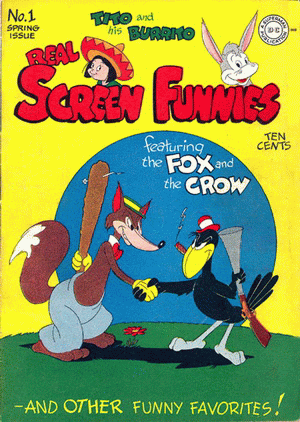 In Spring of 1945 the first issue of Real Screen Funnies hit the stands.
This comic was published by DC and featured a variety of licensed cartoon features. They were in Columbia Studios
cartoons, done by the Screen Gems animation studio. The lead feature of the book was The Fox and the Crow.
Those cartoons were directed by Bob Wickersham and he would also do the early comics. He worked on them
under the Ben Sangor shop called Editorial Art Service. In 1948 James (Jim) F. Davis (no relation to
Garfield creator) would take over working directly for DC. He then continued to work on The Fox and
Crow for 20 years! He was very consistent, came up with fresh stories and kept them popular long after
the cartoons went off the air. The stories were often about the Crow trying to con something out of
the Fox and often getting it. Real Screen Funnies changed to Real Screen Comics with the 2nd issue.
It went 128 issues then changed it's name again to TV Screen Cartoons with issue #129. The series
would go until 1961 and end with issue #138. The Fox and Crow got their own title in 1951 and it went
until 1968, ending with issue #108. Then the title would renamed for a back up feature that grew in
popularity. It was called Stanley and his Monster, but only continued until issue #112.
In Spring of 1945 the first issue of Real Screen Funnies hit the stands.
This comic was published by DC and featured a variety of licensed cartoon features. They were in Columbia Studios
cartoons, done by the Screen Gems animation studio. The lead feature of the book was The Fox and the Crow.
Those cartoons were directed by Bob Wickersham and he would also do the early comics. He worked on them
under the Ben Sangor shop called Editorial Art Service. In 1948 James (Jim) F. Davis (no relation to
Garfield creator) would take over working directly for DC. He then continued to work on The Fox and
Crow for 20 years! He was very consistent, came up with fresh stories and kept them popular long after
the cartoons went off the air. The stories were often about the Crow trying to con something out of
the Fox and often getting it. Real Screen Funnies changed to Real Screen Comics with the 2nd issue.
It went 128 issues then changed it's name again to TV Screen Cartoons with issue #129. The series
would go until 1961 and end with issue #138. The Fox and Crow got their own title in 1951 and it went
until 1968, ending with issue #108. Then the title would renamed for a back up feature that grew in
popularity. It was called Stanley and his Monster, but only continued until issue #112.
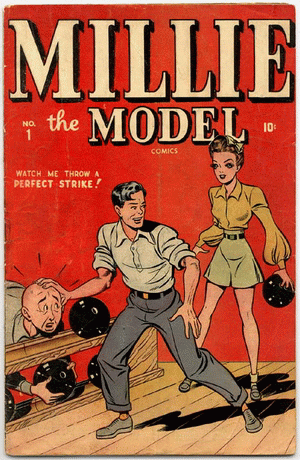 Marvel again tapped into the female audience with Millie the Model in 1945. Millie the Model #1 was written by Stan Lee
and female artist Ruth Atkinson. While Ruth only worked on the first
issue of Millie, she and Stan would collaborate on another popular title called Patsy Walker. Millie
was another working women series. During a time when there were still
some women in the workplace Millie was there to give inspiration to
them all. An added bonus was that Millie could be shown in hairstyles and
fashion ideas submitted by readers. She also appealed to males that like
looking at "good girl" art. This comic would spin off to other titles like
Date with Millie and go through several name changes. But the original Millie
comic went 28 years and 207 issues. It was cancelled in 1973.
Patsy
Walker was another very successful title starting in the summer of 1945
and ending in 1965 (124 issues). Like Millie, Patsy also branched out into other books. Patsy
gained a friend/enemy named Hedy and the two of them got their own title in 1952.
Patsy Walker was also re-made into a superhero named Hellcat many years
after her romance comics days were over. This title along with Millie would be
would be two of Marvel Comics longest lasting Humor/Romance comics.
Marvel again tapped into the female audience with Millie the Model in 1945. Millie the Model #1 was written by Stan Lee
and female artist Ruth Atkinson. While Ruth only worked on the first
issue of Millie, she and Stan would collaborate on another popular title called Patsy Walker. Millie
was another working women series. During a time when there were still
some women in the workplace Millie was there to give inspiration to
them all. An added bonus was that Millie could be shown in hairstyles and
fashion ideas submitted by readers. She also appealed to males that like
looking at "good girl" art. This comic would spin off to other titles like
Date with Millie and go through several name changes. But the original Millie
comic went 28 years and 207 issues. It was cancelled in 1973.
Patsy
Walker was another very successful title starting in the summer of 1945
and ending in 1965 (124 issues). Like Millie, Patsy also branched out into other books. Patsy
gained a friend/enemy named Hedy and the two of them got their own title in 1952.
Patsy Walker was also re-made into a superhero named Hellcat many years
after her romance comics days were over. This title along with Millie would be
would be two of Marvel Comics longest lasting Humor/Romance comics.
Did You Know? - Stan Lee said out of all the
comics series he has written over the years, Millie was his favourite.
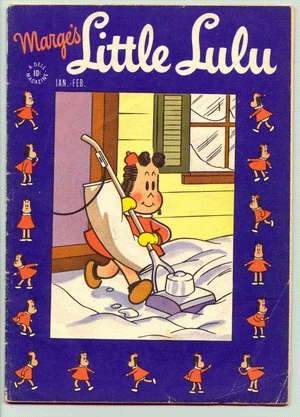 In June of 1945 Little Lulu would make her first appearance in
comic books. She was created by Marjorie Henderson Buell for the
Saturday Evening Post in 1935 and used in single panel cartoons. She
was a smart, strong willed little girl who often pitted her wits
against the neighbourhood boys and their "No Girls Allowed" clubhouse. Her popularity
grew and the character went into comic strips, cartoons, commercials
and with Dell’s Four Color Comics #74, comic books. The comics were
done by John Stanley and Irving Tripp. Stanley would write and layout
the comic stories while Tripp would finish the art. The two made a
great team and produced some of the best all age’s comic books ever.
Lulu would get her own series in 1948 and it would last until 1984
ending with issue 268. Western Printing and Lithography (who got the
licensing rights for Dell to use) also bought the Little Lulu character
outright from Marjorie in 1971, then removed her name from the comic
shortly afterwards.
In June of 1945 Little Lulu would make her first appearance in
comic books. She was created by Marjorie Henderson Buell for the
Saturday Evening Post in 1935 and used in single panel cartoons. She
was a smart, strong willed little girl who often pitted her wits
against the neighbourhood boys and their "No Girls Allowed" clubhouse. Her popularity
grew and the character went into comic strips, cartoons, commercials
and with Dell’s Four Color Comics #74, comic books. The comics were
done by John Stanley and Irving Tripp. Stanley would write and layout
the comic stories while Tripp would finish the art. The two made a
great team and produced some of the best all age’s comic books ever.
Lulu would get her own series in 1948 and it would last until 1984
ending with issue 268. Western Printing and Lithography (who got the
licensing rights for Dell to use) also bought the Little Lulu character
outright from Marjorie in 1971, then removed her name from the comic
shortly afterwards.
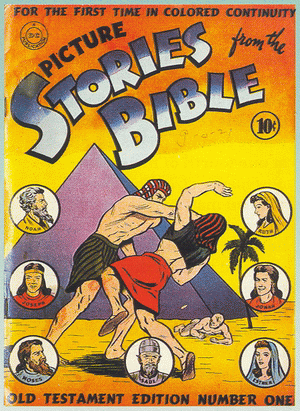 Charlie Max Gaines would sell his All American Comics imprint to DC
comics in 1945. He would then start up his own company called
Educational Comics or EC for short. Max was big believer in using comic
books to educate and put out four titles to do so. The titles were
called Picture Stories from the Bible (1942), Picture Stories from
American History (1946), Picture Stories from World History
and Picture
Stories from Science (both spring 1947). When Max Gaines sold his All American books
to DC, the Bible and American History were two that he kept and moved
over to EC Comics. He would also collect these books into what would today be called
(in the comic industry) trade paper backs or graphic novels. These comics would sell millions
over time and he donated some of the profits to
religious groups. The company would do more comics aimed at children and change it's name to
Entertaining Comics. But before the company could pick up much steam, Max
Gaines died in a boating accident on August 20th, 1947. His son, 25 year old William (Bill) Gaines was
studying to become a high school chemist teacher. At his mothers urging, he dropped out of school and
took over the company. Bill Gaines would radically change the company's output and the industry along
with it.
Charlie Max Gaines would sell his All American Comics imprint to DC
comics in 1945. He would then start up his own company called
Educational Comics or EC for short. Max was big believer in using comic
books to educate and put out four titles to do so. The titles were
called Picture Stories from the Bible (1942), Picture Stories from
American History (1946), Picture Stories from World History
and Picture
Stories from Science (both spring 1947). When Max Gaines sold his All American books
to DC, the Bible and American History were two that he kept and moved
over to EC Comics. He would also collect these books into what would today be called
(in the comic industry) trade paper backs or graphic novels. These comics would sell millions
over time and he donated some of the profits to
religious groups. The company would do more comics aimed at children and change it's name to
Entertaining Comics. But before the company could pick up much steam, Max
Gaines died in a boating accident on August 20th, 1947. His son, 25 year old William (Bill) Gaines was
studying to become a high school chemist teacher. At his mothers urging, he dropped out of school and
took over the company. Bill Gaines would radically change the company's output and the industry along
with it.
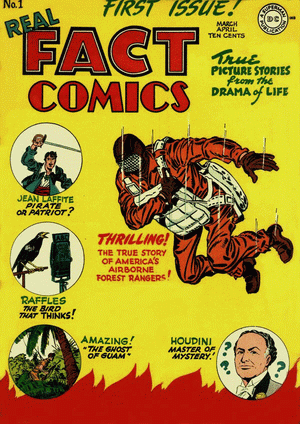 In March, 1946 DC Comics published Real Facts Comics #1. This
comic came out because Editor Jack Schiff liked to educate kids using
comic books. He hired top notch artists like Joe Simon and Jack Kirby
to draw the tales. Despite this, the comic didn't sell that well and
was canceled in 1949 after 21 bimonthly issues. This didn't end the
idea of educating kids through comic books. Because of requests from
schools and a desire to keep a good public image DC comics put a
single public service page in 30 different titles and used the
superheroes to help get the message across. DC Comics also did this to
help counter the negative criticism that comic books were starting to
receive.
In March, 1946 DC Comics published Real Facts Comics #1. This
comic came out because Editor Jack Schiff liked to educate kids using
comic books. He hired top notch artists like Joe Simon and Jack Kirby
to draw the tales. Despite this, the comic didn't sell that well and
was canceled in 1949 after 21 bimonthly issues. This didn't end the
idea of educating kids through comic books. Because of requests from
schools and a desire to keep a good public image DC comics put a
single public service page in 30 different titles and used the
superheroes to help get the message across. DC Comics also did this to
help counter the negative criticism that comic books were starting to
receive.
 In Spring of 1945 the first issue of Real Screen Funnies hit the stands.
This comic was published by DC and featured a variety of licensed cartoon features. They were in Columbia Studios
cartoons, done by the Screen Gems animation studio. The lead feature of the book was The Fox and the Crow.
Those cartoons were directed by Bob Wickersham and he would also do the early comics. He worked on them
under the Ben Sangor shop called Editorial Art Service. In 1948 James (Jim) F. Davis (no relation to
Garfield creator) would take over working directly for DC. He then continued to work on The Fox and
Crow for 20 years! He was very consistent, came up with fresh stories and kept them popular long after
the cartoons went off the air. The stories were often about the Crow trying to con something out of
the Fox and often getting it. Real Screen Funnies changed to Real Screen Comics with the 2nd issue.
It went 128 issues then changed it's name again to TV Screen Cartoons with issue #129. The series
would go until 1961 and end with issue #138. The Fox and Crow got their own title in 1951 and it went
until 1968, ending with issue #108. Then the title would renamed for a back up feature that grew in
popularity. It was called Stanley and his Monster, but only continued until issue #112.
In Spring of 1945 the first issue of Real Screen Funnies hit the stands.
This comic was published by DC and featured a variety of licensed cartoon features. They were in Columbia Studios
cartoons, done by the Screen Gems animation studio. The lead feature of the book was The Fox and the Crow.
Those cartoons were directed by Bob Wickersham and he would also do the early comics. He worked on them
under the Ben Sangor shop called Editorial Art Service. In 1948 James (Jim) F. Davis (no relation to
Garfield creator) would take over working directly for DC. He then continued to work on The Fox and
Crow for 20 years! He was very consistent, came up with fresh stories and kept them popular long after
the cartoons went off the air. The stories were often about the Crow trying to con something out of
the Fox and often getting it. Real Screen Funnies changed to Real Screen Comics with the 2nd issue.
It went 128 issues then changed it's name again to TV Screen Cartoons with issue #129. The series
would go until 1961 and end with issue #138. The Fox and Crow got their own title in 1951 and it went
until 1968, ending with issue #108. Then the title would renamed for a back up feature that grew in
popularity. It was called Stanley and his Monster, but only continued until issue #112. 



